
Tech Swap
See What Happens When A Cat® Racing And A Cat Dealer Technician Trade Places For A Day.
ADDRESSING THE WORKFORCE PROBLEM
If you have looked at job postings anywhere recently, you will have noticed that the bulk of them are technician postings. It’s no secret that this career field faces a critical shortage of skilled tradesman. With at least part of that shortage being due to generational misinformation where getting a college bachelor’s degree is presented as more valuable than gaining skills in a trade. This has led to our current predicament where good techs are hard to find. Even here at Wheeler almost every department is looking for skilled technicians. Of course Wheeler hasn’t just idly sat by either as several steps have been taken to help tackle this shortage. From the in-house apprentice program to their involvement with the Diesel Tech Pathways Group Wheeler is trying to do their part to help address this issue. So when Caterpillar reached out to Wheeler with the idea of swapping a shop technician with a NASCAR tech in an effort to showcase the places this trade can take an individual, the answer was a resounding “yes!”
The scope of this video idea was impressive for such a simple idea. Fly a technician out from Wheeler Machinery to North Carolina, where our sister dealership Carolina Cat would host the shoot since its closest to the Richard Childress Racing campus. Now, I’ve been to Pensacola Florida for military training and Wheeler sent me to Milton Cat in Boston for a training course, but I’ve never been to the mid part of the East Coast. Naturally, the first thing I noticed was the humidity. Though we might not feel it with the rain and the snow that we get in Utah, we are very much so a desert climate and the air doesn’t have a chewiness to it like the states along the coast have. The second thing I noticed was how green everything was. The highways are walled by a lush forest of aged oak, pine and hickory trees. I caught myself remarking to the Cat film crew over and over how we “don’t have this many trees back home” and eventually realized how annoying that must sound. Lucky for me, the understood and got a laugh out of it.
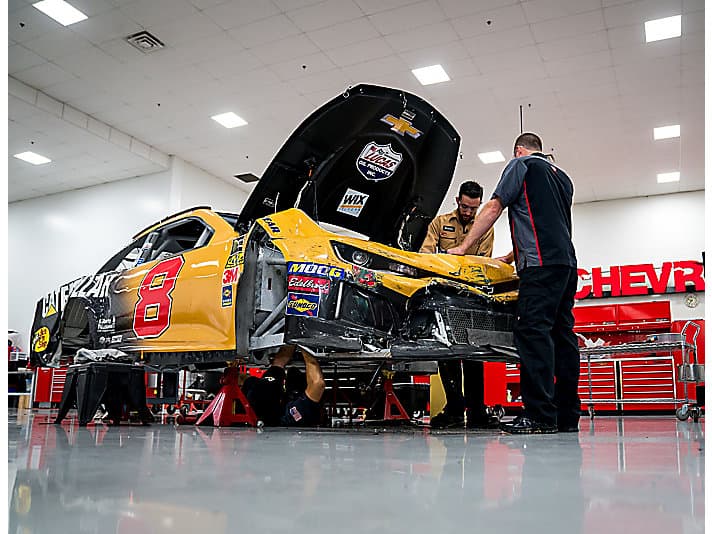
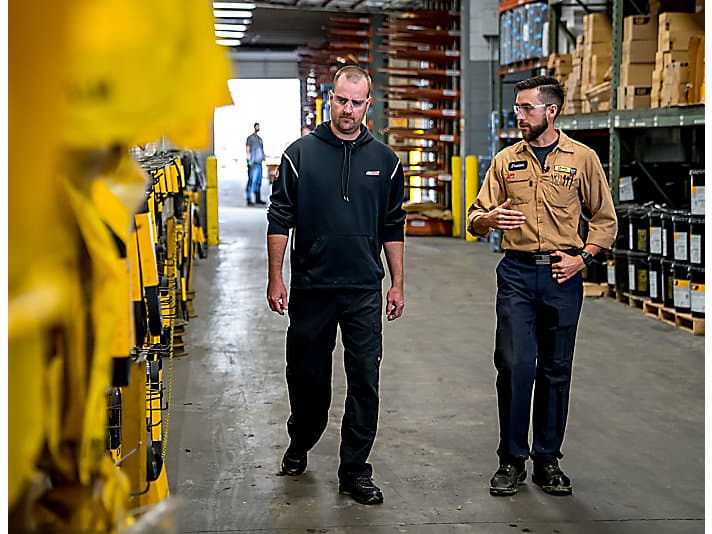
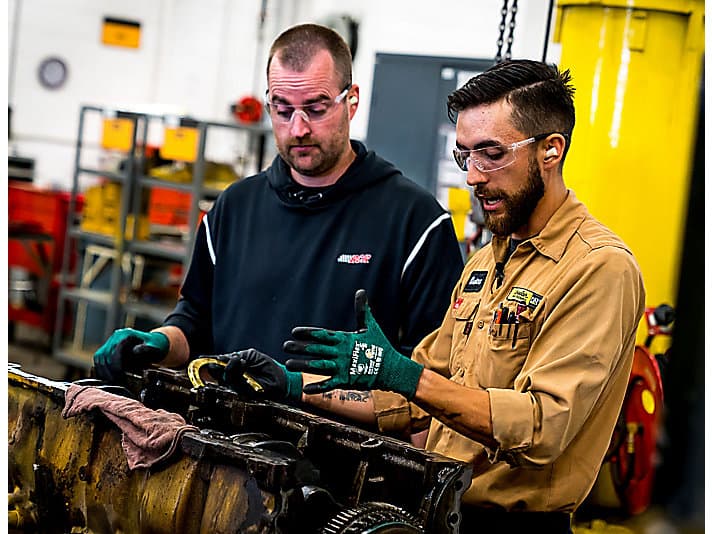
The shoot started at 0800 sharp in a conference room Carolina Cat reserved for us. I met my counterpart Blake Zobrist and we quickly got to talking shop as we both mic’d up and got wired in. Within thirty minutes we were shooting and learning rather rapidly that it’s a lot harder to act on camera than the pros make it look. There was no script and the dialogue was entirely organic to the moment and the scene. Of course, with no script it meant that the scene was redone time and time again because we kept messing up words and laughing at mistakes. Eventually we got the yard scene done and quickly moved on to the other shoot locations in the dealership.
Our scene in parts went much smoother and we were feeling confident in our presentation when we moved to the scene in the shop. For the shop scene we were lucky enough that a Carolina Cat tech was pulling the transmission out of a 745 haul truck and already had the cab off. Despite us having to borrow his project for an extended period of time he was very amiable about the situation and even jokingly asked us if we were going to have the trans out by lunch time. Sadly, our confidence vanished rather quickly as our acting screw ups quickly began to plague our dialogue. With lunch weighing heavily on our minds we were rapidly losing focus and really had to buckle down to get the shot and the scene we were looking for. Finally on take seventeen we got it!
After a much-needed lunch break we moved the shoot into the Carolina Cat CRC where a wise old technician was tearing down a C-18 for a high hour rebuild. We persuaded him to allow us to borrow his tools and pull the crank out for the scene only after some reassurance that I was an actual mechanic and not just an actor pretending to be one. After pulling two main caps I handed the gun to Blake and let him gun the rest of them off. Interestingly enough, he had never used a ¾ impact before as there is nothing on a racecar which requires such force for removal. Gun in hand, he made quick work of the main caps and moved the jib into position for picking. After a quick check on SIS to show Blake the next step we yarded the crank from the block and set it on a pallet to close out our shoot at the main shop.
Our last scene for the day wasn’t going to be shot at the shop, instead it would be shot at Carolina Cat’s Rental Store. Once we got our shooting equipment moved to the Rental Store and set up, the Caterpillar side of the shoot was wrapped up with a reaction interview and a technician interview. The whole experience had given me a better understanding on how fast paced a production style shoot is and a better appreciation of the stress experienced by everyone. That was only day one though… Day two was right around the corner.
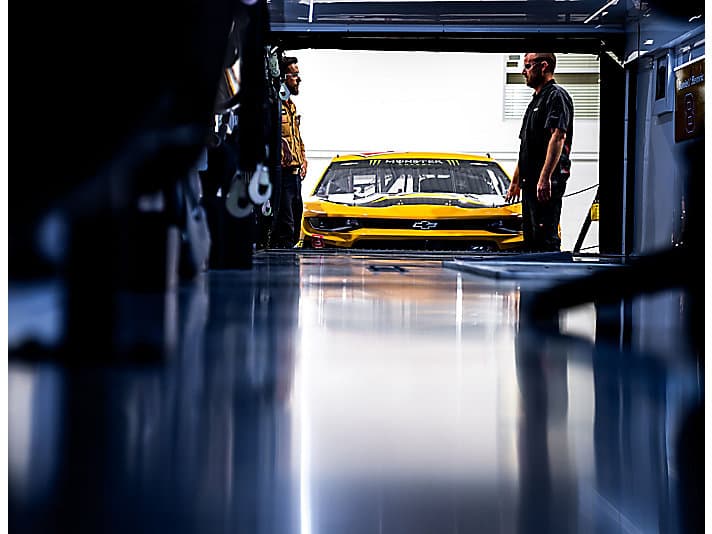
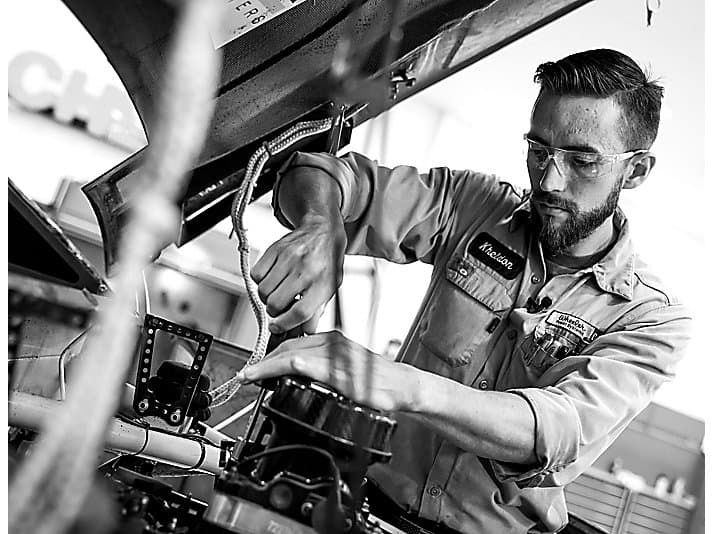
For the second half of the shoot we carpooled to the Richard Childress Racing campus thirty minutes north of our hotel and met up with our RCR Liaison. Two steps into the building and it was like stepping into another world. Four road course cars were lined up front and center for fans of the races to come in and take photos and for folks like us to gawk at. Everything we saw from where we stood spoke of class and prestige. The tile we stood on was dazzled by dazzling our eyes, lit up by the recessed lights hidden high in the vaulted ceiling. A glass case with trophies stood at the far end of the cars. The 50th year commemorative plaque shone prominently on the wall with a custom made Caterpillar Racing stand set beside it. Yeah, we knew we were in the right place.
After setting our gear up in a conference room we walked down to the shop floor and met up with Blake and his team. Quickly setting up the mic’s and the cameras our liaison pulled us in and gave us some ground rules on what could and could not be shown on camera. A quick video fun fact for you; while most of racing is standard and certain regulations keep things on a level playing field there are places where competitive ingenuity is left up to the teams. For example, we couldn’t show any wheel wells without a tire in them because of the potential to reveal proprietary secrets which might help other teams gain an edge. Isn’t that neat?
Once we dialed in the angles we could film at the shoot began. Amusingly enough, both Blake and I had already forgotten how to act in front of the camera and as a result we had to re-shoot the opening scene at least a dozen times before getting a cut we liked. Thankfully by the time we finished the shop tour and walked over to Blake’s workstation it all had come back to us. Good thing too, because it didn’t take long at all before I was told to duck into a wheel well, handed a wrench and told to take a throttle body off of the engine. From there it was like being back in Power Systems, aside from some very different hose clamps and the use of aviation canon plugs, I wouldn’t have known I was working on the Number 8 Car. I even spun a wrench in my pocket purely out of habit instead of setting it down to free up my other hand. Blake found it funny and joked that he and his team would frisk me before letting me leave to make sure I don’t take any accidental souvenirs home. At one point however, I stepped out of the wheel well so Blake could lay some absorbent pads and mop up a power steering fluid spill. While I was talking with the Cat video team the car captain pointed down to the floor and exclaimed that I “was making a mess of his shop!”. Apparently some of the power steering fluid had rehydrated something in the soles of my boots and I was leaving a very distinctive snail trail everywhere I stepped. For some reason the sheer cleanliness of the shop had escaped me when I first set for on the floor but as I stood there I realized just how clean it was and how out of place a dirty diesel mechanic was in such an environment. So I tried to clean my shoes as best as possible but much to my dismay they were still marking the floor. Thankfully Blake came to the rescue with a second pair of boots he had sitting on a shelf by his toolbox.
Now, with me freshly clad in boots one size too big, we pushed on with the engine pick. Within an hour and much to my astonishment, the engine was ready to pick from the chassis. After bolting some lifting links to the heads, moving a cherry picker into position, and guiding it between the front frame rails we had the engine on a stand minutes later. Having picked a lot of engines in my time it was interesting to see the differences between an engine that is designed to last one race as opposed to our engines which are designed to last the life of the machine. It’s still awesome to think that the engine we pulled from the car had only been in chassis for one week and only made it one race before we picked it.
Satisfied with the shoot Blake offered a personalized tour of the transport truck before got a scene where He and I loaded a car. The only thing left to do now was to wrap up the day with a reaction interview and Blakes technician interview. The whole experience was quickly finished after that and while it had only been a two day shoot it held a lifetime of memories.
Now, this isn’t just a neat experience for a fun video, it’s an important effort to try and change the misunderstandings of this industry. It’s a way to address the negative connotations that are attached to the title “mechanic”. The stigma of being an uneducated knuckle dragger couldn’t be further from the truth. Engine management systems are becoming more complex and technologically dependent. Equipment now has more ECM’s than ever before with more and more computer involvement. These advancements require mechanics to be able to adapt and understand data while maintaining the skillset to diagnose and repair the older mechanical equipment that is still working on jobsites. These are just a few examples of what we face in this industry, I know that there are more. The problem however is that most outside our world don’t understand what mechanics do and they only have those misguided stigmas to base an understanding off of. We need to help change that mindset if we can continue to meet the demands of the service industry. We need to help educate the workforce about what we do. We need to share our experiences and encourage others to do the same.
In the next few weeks, Caterpillar will be promoting the remaining two videos from the shoot. I highly encourage you to share them as much as you can along with your take on this industry. If you like, you can go to Caterpillar Inc’s YouTube channel and share the videos from there or go to their Facebook page where they have the first video posted and share it there. Keep an eye out for a written article to be posted up as well if you would like to share that for anyone looking to this industry as a career. Remember, it’s up to you to help change the face of this industry!
Kheldon Stapley
December 2019
Wheeler Power Systems